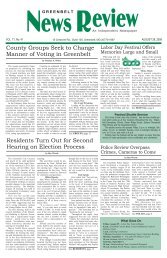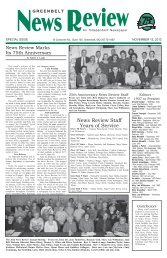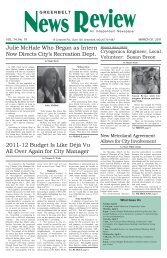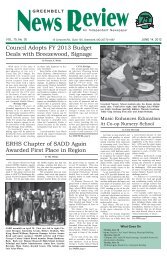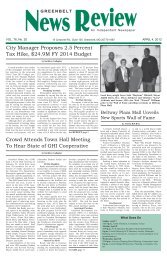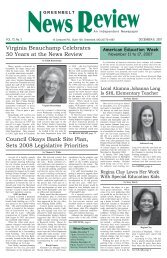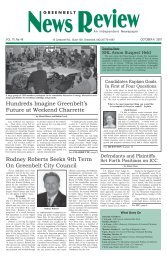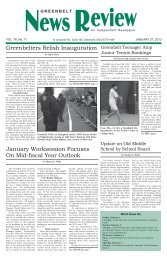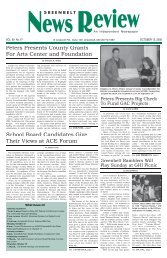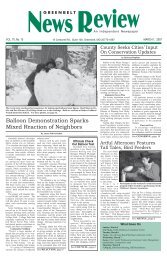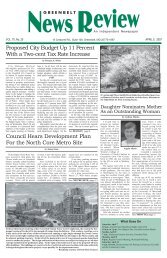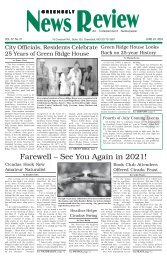Public Works Budget - Greenbelt News Review
Public Works Budget - Greenbelt News Review
Public Works Budget - Greenbelt News Review
You also want an ePaper? Increase the reach of your titles
YUMPU automatically turns print PDFs into web optimized ePapers that Google loves.
Page 6 GREENBELT NEWS REVIEW Thursday, May 17, 2012<br />
Questions & Answers –<br />
About Proposed Sector Plan<br />
At the April 19 workshop,<br />
Project Manager Chad Williams<br />
provided staff resources to a list<br />
of questions raised about the<br />
sector plan during the last year<br />
of workshops, reflecting current<br />
thinking as staff begins writing<br />
the Preliminary Sector Plan. Below<br />
is a condensed summary of<br />
the questions and answers: for the<br />
full set and additional information,<br />
go to: www.pgplanning.org/<br />
greenbelt.htm.<br />
Q. What do you mean by<br />
short, medium and long-term<br />
phasing?<br />
A. Since the overall horizon<br />
of the Sector Plan will extend to<br />
2040, slightly less than 30 years,<br />
the phasing for the Sector Plan<br />
will break down as 0-5 years for<br />
the short term, 5-15 years for<br />
medium term and 15-30 years for<br />
long term.<br />
Q. Are you considering downgrading<br />
the General Plan designation<br />
of the <strong>Greenbelt</strong> Metro<br />
Metropolitan Center (MC)?<br />
A. No. Staff evaluated the<br />
General Plan recommendations<br />
for metropolitan centers and the<br />
two recommended land-use approaches<br />
– mixed-use development<br />
(MUD) and major employer/General<br />
Services Administration<br />
(GSA) tenant at the North<br />
Core – and determined that MC<br />
is the appropriate designation.<br />
However, the MC boundaries<br />
likely will be refined.<br />
Q. What do you mean by<br />
residential-medium, residential<br />
medium-high and residential-high<br />
densities?<br />
A. The Planning Department<br />
uses a land-use classification<br />
system that employs these categories.<br />
Residential Medium<br />
describes detached/attached dwelling<br />
units with densities between<br />
three and eight units per acre,<br />
such as the single-family neighborhoods<br />
of North College Park<br />
and Berwyn Heights. Residential<br />
Medium-High refers to densities<br />
between eight and 20 units per<br />
acre, similar to a townhome or<br />
garden-style apartment complex<br />
and Residential High would apply<br />
to densities higher than 20 units<br />
per acre, that could involve a mix<br />
of housing types likely including<br />
elevator apartment buildings and<br />
other higher-intensity development.<br />
Q. What is the relevance of<br />
the 2001 <strong>Greenbelt</strong> Metro Area<br />
Sector Plan?<br />
A. Many concepts from the<br />
2001 plan are relevant. Connectivity,<br />
safety and the natural<br />
environment are still important<br />
today. Trail connections from<br />
the <strong>Greenbelt</strong> Metro to Cherrywood<br />
Lane, a pedestrian bridge<br />
to North College Park, the linkage<br />
of transportation and phasing<br />
of development and preservation<br />
of the state-owned parcel along<br />
Indian Creek will be part of the<br />
Preliminary Sector Plan.<br />
Q. Why is the preliminary<br />
plan likely to include different<br />
land use approaches?<br />
A. Future development of<br />
<strong>Greenbelt</strong> Metro Station North<br />
Core will play a significant role<br />
in how the rest of the Sector<br />
Plan area grows over time and<br />
will have different impacts on the<br />
Sector Plan Area and the neighboring<br />
communities.<br />
As the Green Line terminus<br />
<strong>Greenbelt</strong> station has enormous<br />
potential for local communities,<br />
the county and the region. Its<br />
current use as a surface parking<br />
facility is the least desirable<br />
outcome. Development of either<br />
a transit-oriented, mixed-use<br />
community or a major employer<br />
such as a GSA tenant (with some<br />
potential for associated mixed-use<br />
development) offers the highest<br />
return on investment and maximize<br />
potential gains for this site.<br />
However, staff is unable to predict<br />
which of these two options is<br />
most likely to occur at the North<br />
Core. The preliminary sector<br />
plan will investigate the potential<br />
impacts and benefits of both recommended<br />
land-use approaches.<br />
Q. What is the justification for<br />
new residential development?<br />
A. Key factors indicating the<br />
need for new residential development<br />
at Metro Station and other<br />
areas are regional demand for<br />
new homes, particularly transitfriendly;<br />
shifting populations;<br />
new area employment opportunities;<br />
support for existing and new<br />
retail; and the suitability of existing<br />
sites with transportation and<br />
utility infrastructure already in<br />
place. These land-use approaches<br />
would likely result in an overall<br />
net reduction in the amount of<br />
residential development already<br />
approved within the Sector Plan<br />
Area.<br />
Q. Why is the Pedestrian<br />
Bridge to North College Park<br />
still recommended?<br />
A. A second pedestrian connection<br />
to North College Park<br />
will ensure safe pedestrian and<br />
bicycle connections between the<br />
largely residential neighborhood<br />
and future North Core uses such<br />
as restaurants and shopping and<br />
safe pedestrian pathways to a<br />
proposed new elementary school.<br />
In addition, the Conceptual Site<br />
Plan for the North Core mandates<br />
a pedestrian bridge as a condition<br />
of approval.<br />
Q. Why are you not reflecting<br />
the final alignment of the<br />
North/South Connector linking<br />
the North and South Core areas?<br />
A. Some preliminary engineering<br />
and design work has been<br />
done but the final alignment has<br />
not been determined. Staff is<br />
aware of community concerns<br />
with the impact of the road’s<br />
proximity and traffic noise on<br />
existing residential areas. The<br />
Preliminary Sector Plan will address<br />
the road’s alignment.<br />
Q. Where is the ramp system<br />
for the proposed (full) Beltway<br />
Interchange on the concept drawings?<br />
A. The proposed interchange<br />
ramp system will be reflected<br />
in the Preliminary Sector Plan<br />
for conceptual and illustrative<br />
purposes only. Once funding is<br />
allocated to engineering and design,<br />
the final alignment will be<br />
determined.<br />
Q. Do you support bus transit/<br />
bicycling/walkability?<br />
A. Yes, absolutely. The Preliminary<br />
Sector Plan will include<br />
discussion and additional details<br />
on the trail and sidewalk network;<br />
transit routes and coordination;<br />
amenities for bus riders,<br />
walkers, and cyclists; and more.<br />
Cost estimates will be generated<br />
for trails, bicycle facilities,<br />
sidewalks, “complete streets,”<br />
transit amenities, new transit<br />
lines, and other appropriate measures.<br />
The costs will be included<br />
in a comprehensive review of<br />
proposed public facilities by the<br />
Preliminary Sector Plan.<br />
On another topic, the preliminary<br />
sector plan will make no<br />
recommendations for development<br />
of North College Park.<br />
SECTOR PLAN<br />
continued from page 1<br />
turn flow through their own set<br />
of signal lights and improve eastwest<br />
traffic flows. He said this<br />
design would improve safety for<br />
pedestrians and bicyclists. Several<br />
residents were not entirely<br />
convinced after viewing a film<br />
presentation of a similar intersection.<br />
North Core<br />
Two alternatives are being<br />
considered for the North Core at<br />
<strong>Greenbelt</strong> Station – a mediumto-high<br />
density transit-oriented<br />
neighborhood or an urban campus<br />
serving a major employer with<br />
the possibility of some mixeduse<br />
(MU) development. In either<br />
case the North Core will include<br />
“eco-district” features such as<br />
connectivity, use as a transit hub,<br />
indoor/outdoor recreation, welldesigned<br />
parking and preservation<br />
of the Indian Creek and Narragansett<br />
Run tributaries. On the<br />
consolidated master plan map that<br />
will show the Sector Plan area, a<br />
new blue color stripe will denote<br />
“Major Employer” in the North<br />
Core section.<br />
Franklin Park likely would<br />
be a phased redevelopment and<br />
continue as mainly residential<br />
with more open space and public<br />
facilities, neighborhood retail and<br />
three new community gateways.<br />
Williams noted that the preliminary<br />
plan would recommend that<br />
the regional school bus parking lot<br />
on <strong>Greenbelt</strong> Road be relocated<br />
to a more central location. Cherrywood<br />
Lane would maintain the<br />
current 80-foot right of way but it<br />
would be transformed into a twolane<br />
divided boulevard with full<br />
signals at the intersection of Cherrywood<br />
and Metro Access Drive.<br />
However, the city has plans for<br />
a roundabout facility at that location.<br />
The plan for Capital Office<br />
Park would improve circulation,<br />
increase public spaces and offer<br />
potential for office infill.<br />
In <strong>Greenbelt</strong> East, a comprehensive<br />
phased redevelopment<br />
of Greenway Center should be<br />
undertaken with a mix of uses<br />
and more open space and trail<br />
connections. As noted in previous<br />
articles, the Hanover Parkway area<br />
should try to take advantage of<br />
the nearby hospital and the medical<br />
offices on Hanover Parkway<br />
and within the Office Park.<br />
Also discussed were how design<br />
elements could build on local<br />
history, integrate with the<br />
environment and provide more<br />
open space and safe pedestrian<br />
access. Development should follow<br />
District Development Overlay<br />
Zone guidelines and employ best<br />
practices on passive crime prevention,<br />
storm water management and<br />
green building techniques.<br />
There is to be a midsummer<br />
release of the Preliminary Sector<br />
Plan for public comment. A<br />
joint public hearing by the Prince<br />
George’s Planning Board and the<br />
county council will take place in<br />
September, and county planning<br />
board approval is scheduled in<br />
late fall. In early 2013 the District<br />
Council is set to approve the<br />
Sector Plan.<br />
For more details visit www.<br />
pgplanning.org/<strong>Greenbelt</strong>.htm.<br />
MISC. BUDGETS cont. from page 1<br />
the city are accounted for in the<br />
various departmental budgets.<br />
However, actuarial reviews have<br />
determined that the city plans<br />
are underfunded and the city<br />
is obligated to make additional<br />
contributions. McLaughlin expects<br />
these contributions to total<br />
$221,400 for the coming year, Fiscal<br />
Year 2013. McLaughlin noted<br />
that the state retirement system,<br />
which manages the city plans, is<br />
charging 7 percent interest on the<br />
unfunded liability owed by the<br />
city. He would like to see that<br />
debt refinanced by the city to save<br />
interest costs but notes that the<br />
cost of doing so may be too great<br />
to achieve significant savings. He<br />
will explore this alternative farther.<br />
Transfers to Other Funds<br />
The budget proposes transferring<br />
$950,000 to other city funds.<br />
This is $235,000 less than for the<br />
current year. The reduction is<br />
due to the significant cost savings<br />
achieved by the city when it refinanced<br />
its debt.<br />
The first fund listed is the<br />
Building Capital Reserve Fund.<br />
This is one of several city special<br />
revenue funds that receive annual<br />
payments at relatively level<br />
amounts to be used for capital<br />
expenditures. Since the expenses<br />
can fluctuate substantially from<br />
year to year and could therefore<br />
cause extraordinary swings in the<br />
amount of the city budget, it is<br />
believed that putting aside funds<br />
each year provides for a more<br />
fiscally sound financial operation.<br />
For FY13, the $150,000 transfer<br />
of city funds is expected to<br />
be supplemented with $60,000<br />
of grant money. In the fund,<br />
money is budgeted to replace the<br />
50-year old floor in the Youth<br />
Center ($50,000), undertake a<br />
study of the heating, ventilating<br />
and air conditioning system at the<br />
Community Center ($90,000) and<br />
undertake other energy efficiency<br />
improvements to city buildings<br />
($10,000).<br />
In the Debt Service Fund,<br />
which will receive $300,000 from<br />
city’s General Fund, $319,100<br />
is budgeted to pay principal and<br />
interest on the city’s debt obligations.<br />
There will be a fund<br />
balance of $346,000 of which<br />
$232,000 was set aside by the<br />
council to use to match grants<br />
for the renovation of the <strong>Greenbelt</strong><br />
Theater movie house. As of<br />
July 1, city debt will be under<br />
$3.700.000, well below its legal<br />
debt limit.<br />
The Replacement Fund receives<br />
money annually from the General<br />
Fund ($150,000 this budget) to<br />
be used to replace city equipment<br />
when needed. Proposed expenditures<br />
this year will be for a cargo<br />
van, the city’s share of the cost of<br />
a new street sweeper shared with<br />
other cities, six exercise machines<br />
for the Fitness Center and two<br />
pick-up trucks and a truck body<br />
for Parks.<br />
Still More Funds<br />
There are a variety of funds<br />
included in the budget that generally<br />
are not supported by city<br />
tax funds. The Cemetery Fund<br />
accounts for maintenance of the<br />
small city cemetery off Ivy Lane<br />
using the proceeds from the sale<br />
of cemetery lots and income<br />
earned from investing these excess<br />
funds. While there are no<br />
longer lots for sale, the city receives<br />
nominal income from service<br />
fees for burials that may still<br />
take place. However, the nominal<br />
$3,000 budgeted for maintenance<br />
will still exceed the income from<br />
interest and service fees by ten<br />
fold.<br />
A fund that can vary significantly<br />
from year to year is the<br />
Special Projects Fund, which accounts<br />
for special expenditures<br />
paid for by the city out of funds<br />
received from others. In this<br />
budget, the largest revenue source<br />
is the city’s share of cable TV<br />
franchise fees which are used<br />
to pay the cost of operating the<br />
city’s public access channel. A<br />
special cost for this year will be<br />
the city’s 75th Anniversary events<br />
for which fees are charged, such<br />
as the planned dinner-dance in<br />
October.<br />
Agency Funds consist of 11<br />
special funds to account for special<br />
revenue received by the city<br />
designated for use for special<br />
purposes. Both the Recreation<br />
Department and <strong>Greenbelt</strong> CARES<br />
receive donations used for special<br />
purposes. The Good Samaritan<br />
Fund was established by the<br />
<strong>Greenbelt</strong> ministry as a way to<br />
provide assistance to travelers in<br />
financial need. Similarly an emergency<br />
assistance fund has been<br />
established to help needy residents<br />
pay rents, using donations<br />
received. The Adopt-A-Tree Program<br />
accounts for donations used<br />
to plant trees throughout the city.<br />
Funds confiscated by the police,<br />
such as illegal drug money, are<br />
accounted for in the Confiscated<br />
Funds Fund. If, upon adjudication,<br />
these funds are awarded to<br />
the city. they are used for police<br />
purposes. The Advisory Committee<br />
on Education receives donations<br />
from time to time and a<br />
special fund was established to<br />
account for donations to save the<br />
<strong>Greenbelt</strong> Theater.<br />
One fund receives annual contributions<br />
from the city allocated<br />
to purchase new fire equipment<br />
for the <strong>Greenbelt</strong> Volunteer Fire<br />
Department and Rescue Squad,<br />
Inc. from time to time. This<br />
year’s contribution is $88,000.<br />
Donations are made to the Animal<br />
Shelter to pay for the cost of neutering<br />
animals at the city clinic, an<br />
expense that should save the city<br />
money in the long run.<br />
Another major agency fund<br />
accounts for the cost of operating<br />
Green Ridge House, the city-owned<br />
apartment house for low-income<br />
seniors and disabled. The $1.4<br />
million budget, supported solely<br />
by rents and federal Section 8<br />
rental assistance funds, is reviewed<br />
by council with the apartment’s<br />
management at a separate meeting.<br />
Lastly, there are three funds to<br />
account for city capital projects.<br />
Since expenditures in these funds<br />
may be spread over a period of<br />
years and do not rely upon annual<br />
appropriations but instead upon appropriations<br />
that council makes<br />
from time to time that remain in<br />
effect until the project is completed,<br />
council chooses to consider these<br />
funds in detail later in the year, after<br />
the annual budget is adopted.<br />
Wear White At Night



